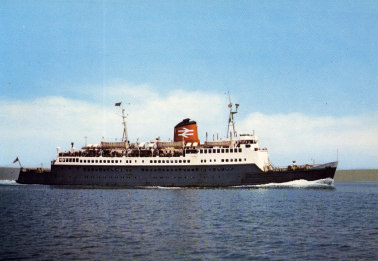Caesarea and her sister Sarnia, completed at the J. Samuel White shipyard at East Cowes on the Isle of Wight in 1960 and 1961, were notable 'end of an era' ships in a variety of ways. Not only were they the final passenger ferries to be built for the Channel Islands services, they were the last conventional (ie non-high speed) ferries of any type to be built for that market for 38 years, and most definitely the final steamships; after the rather unique Avalon of Harwich, the pair were the penultimate 'classic' British open sea railway passenger ships. They were by far the largest ferries that had been built at that time for the Islands, although their passenger capacity was just 1,400 in one class accommodation.
Based at Weymouth (rather than the traditional Southampton), the pair had little reason to depart from the route for which they were built, although Caesarea had a spell running the Golden Arrow from Dover in the winter of 1965/66. The coming of the car ferry to the islands in 1973, albeit with the little converted Falaise, was a clear signal that there was little time left for Caesarea and Sarnia's classic-style of service. The end for Caesarea came in October 1975 when she made her final scheduled sailing to the islands. Sarnia continued until 1977 - replacements for the sisters and the decrepit Falaise came in the form of the car ferries Earl Godwin, Caledonian Princess and finally Earl William (in 1978).
Caesarea was not finished yet though - in an enterprising move, Sealink moved the ship to Dover and Folkestone from early 1976 to operate classic passenger sailings to Calais and Boulogne, in lieu of the retired Maid of Orleans of 1949. Sarnia was not so lucky, and after finishing at Weymouth in 1977, she was sold for ignominious service as Aquamart, a floating duty-free supermarket based at Oostende, a venture soon scuppered by unsympathetic Belgian customs officials. Caesarea meanwhile finally ended operations for Sealink on the Dover Strait after the 1980 season.
The destinies of the sisters after this is disappointingly shrouded in mystery. What is clear is that, despite lingering for some years, they ultimately headed for breakers far away from the English Channel within eight months of each other. It was Sarnia which lasted slightly longer - after the failed Aquamart venture, she passed to owners in Jeddah. Following spells as Golden Star and Saudi Golden Star, she was broken up in early 1987 on the beaches of Pakistan, miserable graveyard for hundreds of ships.
After completing her Sealink service Caesarea was fairly quickly sold to Hong Kong interests, and in December 1980 she sailed to the far east under the name Aesarea. Brief service as a hotel ship appears to have followed and she was later taken to Japan for further use; but the ship was to finally end her days in the hands of Korean breakers, sailing to meet her doom in June 1986. |











